Work Health and Safety Assessment
VerifiedAdded on 2023/06/08
|12
|2368
|175
AI Summary
The report summarizes the risk assessment outcomes for the food preparation area of a catering business. The six steps of the work health and safety risk assessment process gives the insight that it is an appropriate strategy to determine the nature and severity of harm at workplace and determine appropriate control measures too.
Contribute Materials
Your contribution can guide someone’s learning journey. Share your
documents today.
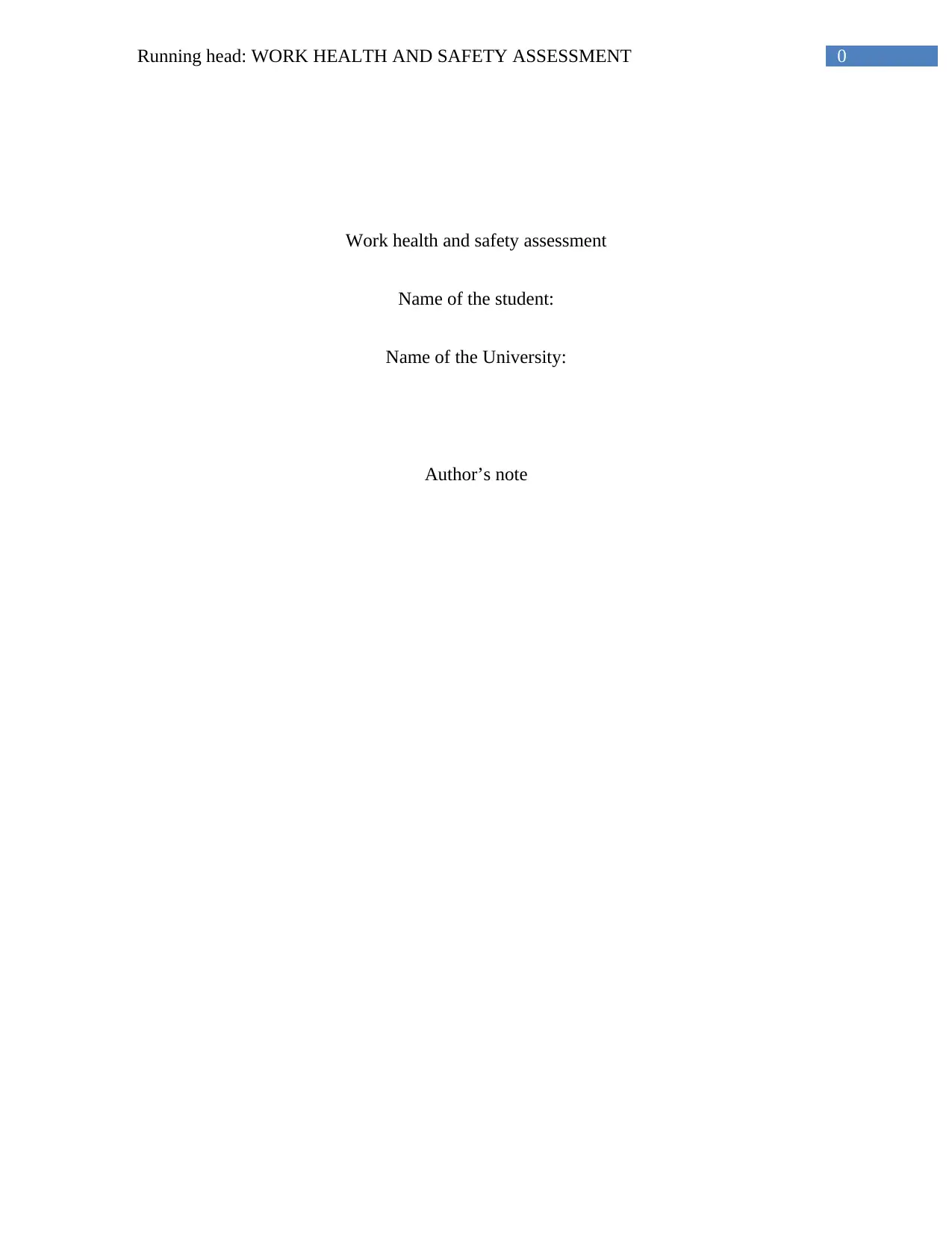
0Running head: WORK HEALTH AND SAFETY ASSESSMENT
Work health and safety assessment
Name of the student:
Name of the University:
Author’s note
Work health and safety assessment
Name of the student:
Name of the University:
Author’s note
Secure Best Marks with AI Grader
Need help grading? Try our AI Grader for instant feedback on your assignments.
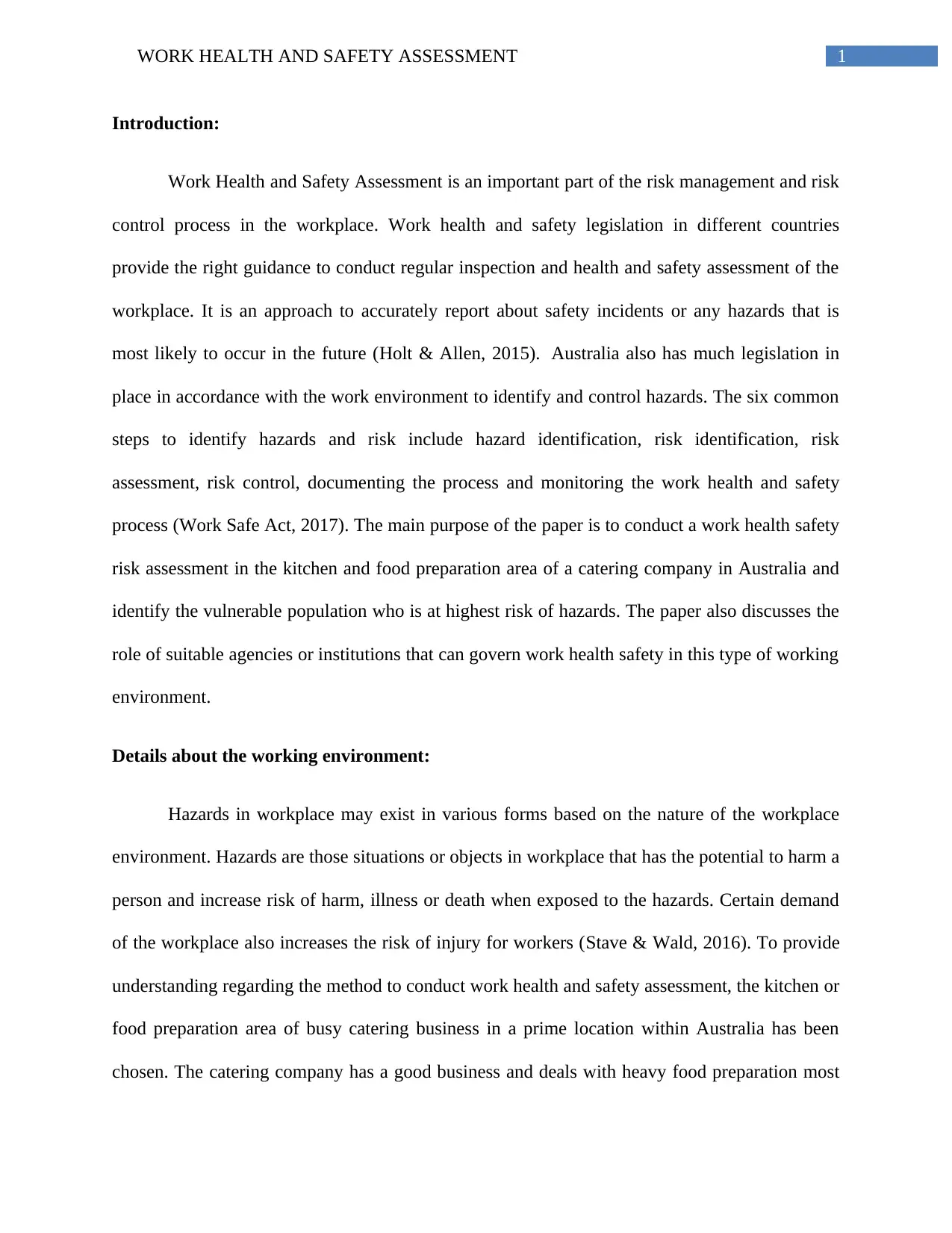
1WORK HEALTH AND SAFETY ASSESSMENT
Introduction:
Work Health and Safety Assessment is an important part of the risk management and risk
control process in the workplace. Work health and safety legislation in different countries
provide the right guidance to conduct regular inspection and health and safety assessment of the
workplace. It is an approach to accurately report about safety incidents or any hazards that is
most likely to occur in the future (Holt & Allen, 2015). Australia also has much legislation in
place in accordance with the work environment to identify and control hazards. The six common
steps to identify hazards and risk include hazard identification, risk identification, risk
assessment, risk control, documenting the process and monitoring the work health and safety
process (Work Safe Act, 2017). The main purpose of the paper is to conduct a work health safety
risk assessment in the kitchen and food preparation area of a catering company in Australia and
identify the vulnerable population who is at highest risk of hazards. The paper also discusses the
role of suitable agencies or institutions that can govern work health safety in this type of working
environment.
Details about the working environment:
Hazards in workplace may exist in various forms based on the nature of the workplace
environment. Hazards are those situations or objects in workplace that has the potential to harm a
person and increase risk of harm, illness or death when exposed to the hazards. Certain demand
of the workplace also increases the risk of injury for workers (Stave & Wald, 2016). To provide
understanding regarding the method to conduct work health and safety assessment, the kitchen or
food preparation area of busy catering business in a prime location within Australia has been
chosen. The catering company has a good business and deals with heavy food preparation most
Introduction:
Work Health and Safety Assessment is an important part of the risk management and risk
control process in the workplace. Work health and safety legislation in different countries
provide the right guidance to conduct regular inspection and health and safety assessment of the
workplace. It is an approach to accurately report about safety incidents or any hazards that is
most likely to occur in the future (Holt & Allen, 2015). Australia also has much legislation in
place in accordance with the work environment to identify and control hazards. The six common
steps to identify hazards and risk include hazard identification, risk identification, risk
assessment, risk control, documenting the process and monitoring the work health and safety
process (Work Safe Act, 2017). The main purpose of the paper is to conduct a work health safety
risk assessment in the kitchen and food preparation area of a catering company in Australia and
identify the vulnerable population who is at highest risk of hazards. The paper also discusses the
role of suitable agencies or institutions that can govern work health safety in this type of working
environment.
Details about the working environment:
Hazards in workplace may exist in various forms based on the nature of the workplace
environment. Hazards are those situations or objects in workplace that has the potential to harm a
person and increase risk of harm, illness or death when exposed to the hazards. Certain demand
of the workplace also increases the risk of injury for workers (Stave & Wald, 2016). To provide
understanding regarding the method to conduct work health and safety assessment, the kitchen or
food preparation area of busy catering business in a prime location within Australia has been
chosen. The catering company has a good business and deals with heavy food preparation most
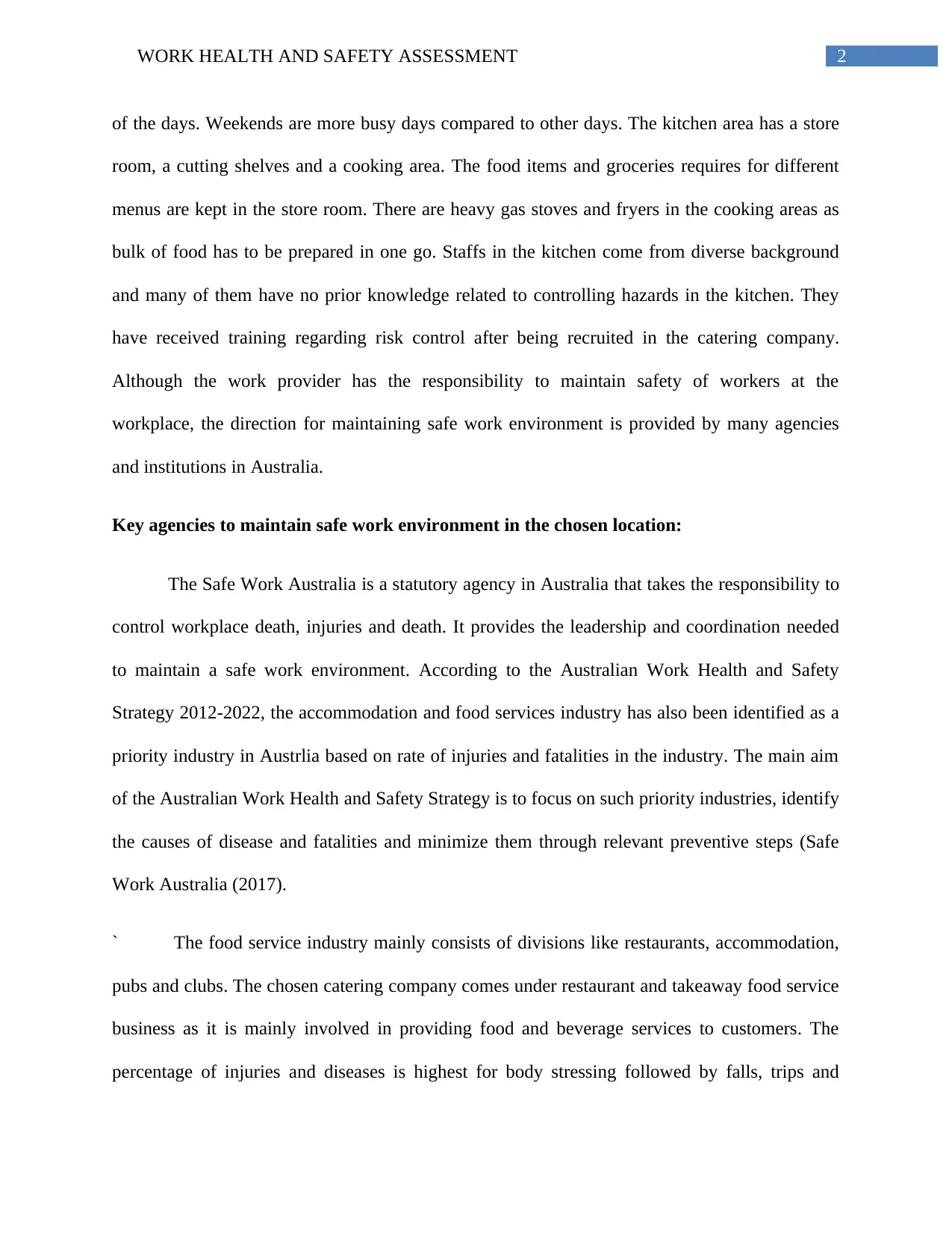
2WORK HEALTH AND SAFETY ASSESSMENT
of the days. Weekends are more busy days compared to other days. The kitchen area has a store
room, a cutting shelves and a cooking area. The food items and groceries requires for different
menus are kept in the store room. There are heavy gas stoves and fryers in the cooking areas as
bulk of food has to be prepared in one go. Staffs in the kitchen come from diverse background
and many of them have no prior knowledge related to controlling hazards in the kitchen. They
have received training regarding risk control after being recruited in the catering company.
Although the work provider has the responsibility to maintain safety of workers at the
workplace, the direction for maintaining safe work environment is provided by many agencies
and institutions in Australia.
Key agencies to maintain safe work environment in the chosen location:
The Safe Work Australia is a statutory agency in Australia that takes the responsibility to
control workplace death, injuries and death. It provides the leadership and coordination needed
to maintain a safe work environment. According to the Australian Work Health and Safety
Strategy 2012-2022, the accommodation and food services industry has also been identified as a
priority industry in Austrlia based on rate of injuries and fatalities in the industry. The main aim
of the Australian Work Health and Safety Strategy is to focus on such priority industries, identify
the causes of disease and fatalities and minimize them through relevant preventive steps (Safe
Work Australia (2017).
` The food service industry mainly consists of divisions like restaurants, accommodation,
pubs and clubs. The chosen catering company comes under restaurant and takeaway food service
business as it is mainly involved in providing food and beverage services to customers. The
percentage of injuries and diseases is highest for body stressing followed by falls, trips and
of the days. Weekends are more busy days compared to other days. The kitchen area has a store
room, a cutting shelves and a cooking area. The food items and groceries requires for different
menus are kept in the store room. There are heavy gas stoves and fryers in the cooking areas as
bulk of food has to be prepared in one go. Staffs in the kitchen come from diverse background
and many of them have no prior knowledge related to controlling hazards in the kitchen. They
have received training regarding risk control after being recruited in the catering company.
Although the work provider has the responsibility to maintain safety of workers at the
workplace, the direction for maintaining safe work environment is provided by many agencies
and institutions in Australia.
Key agencies to maintain safe work environment in the chosen location:
The Safe Work Australia is a statutory agency in Australia that takes the responsibility to
control workplace death, injuries and death. It provides the leadership and coordination needed
to maintain a safe work environment. According to the Australian Work Health and Safety
Strategy 2012-2022, the accommodation and food services industry has also been identified as a
priority industry in Austrlia based on rate of injuries and fatalities in the industry. The main aim
of the Australian Work Health and Safety Strategy is to focus on such priority industries, identify
the causes of disease and fatalities and minimize them through relevant preventive steps (Safe
Work Australia (2017).
` The food service industry mainly consists of divisions like restaurants, accommodation,
pubs and clubs. The chosen catering company comes under restaurant and takeaway food service
business as it is mainly involved in providing food and beverage services to customers. The
percentage of injuries and diseases is highest for body stressing followed by falls, trips and
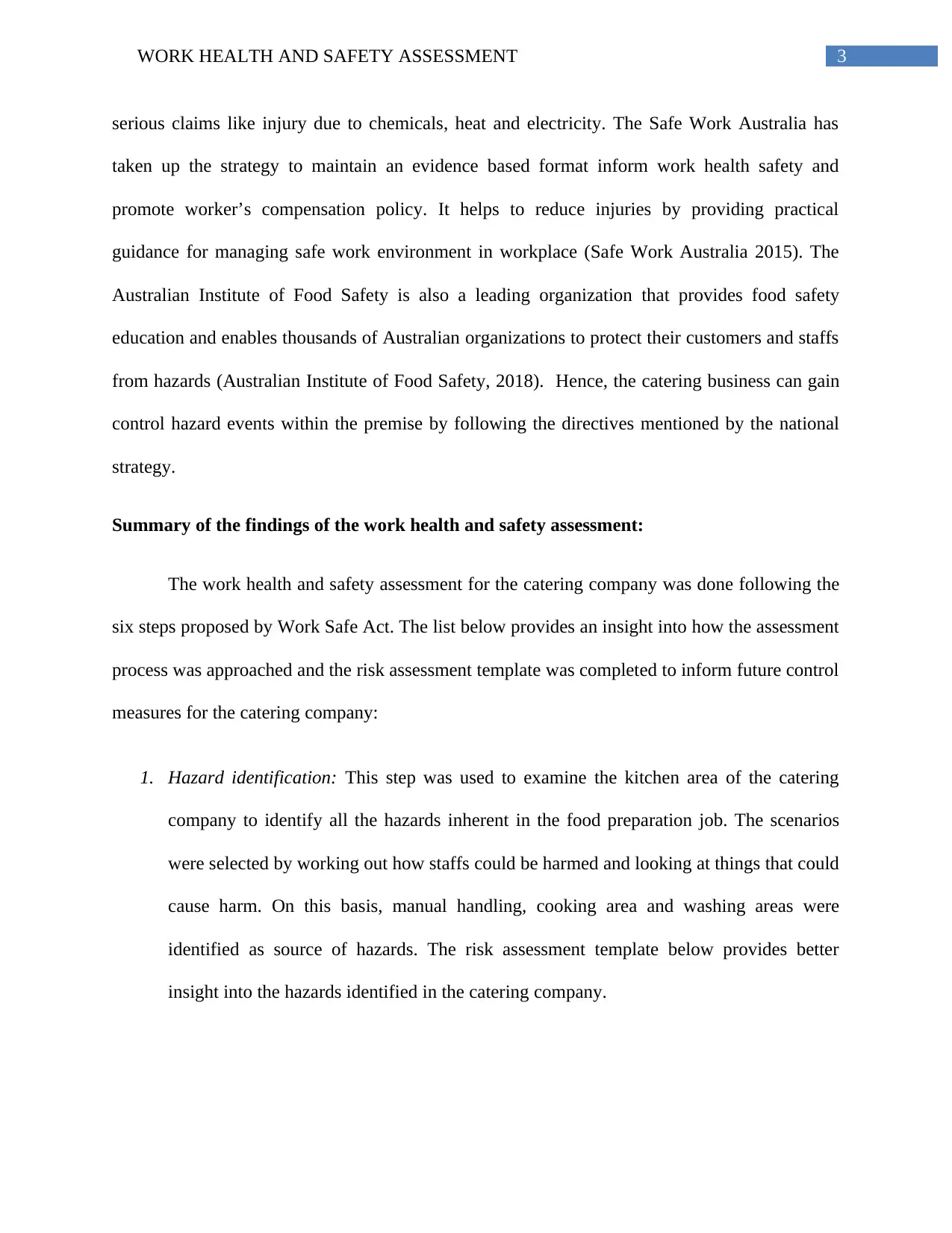
3WORK HEALTH AND SAFETY ASSESSMENT
serious claims like injury due to chemicals, heat and electricity. The Safe Work Australia has
taken up the strategy to maintain an evidence based format inform work health safety and
promote worker’s compensation policy. It helps to reduce injuries by providing practical
guidance for managing safe work environment in workplace (Safe Work Australia 2015). The
Australian Institute of Food Safety is also a leading organization that provides food safety
education and enables thousands of Australian organizations to protect their customers and staffs
from hazards (Australian Institute of Food Safety, 2018). Hence, the catering business can gain
control hazard events within the premise by following the directives mentioned by the national
strategy.
Summary of the findings of the work health and safety assessment:
The work health and safety assessment for the catering company was done following the
six steps proposed by Work Safe Act. The list below provides an insight into how the assessment
process was approached and the risk assessment template was completed to inform future control
measures for the catering company:
1. Hazard identification: This step was used to examine the kitchen area of the catering
company to identify all the hazards inherent in the food preparation job. The scenarios
were selected by working out how staffs could be harmed and looking at things that could
cause harm. On this basis, manual handling, cooking area and washing areas were
identified as source of hazards. The risk assessment template below provides better
insight into the hazards identified in the catering company.
serious claims like injury due to chemicals, heat and electricity. The Safe Work Australia has
taken up the strategy to maintain an evidence based format inform work health safety and
promote worker’s compensation policy. It helps to reduce injuries by providing practical
guidance for managing safe work environment in workplace (Safe Work Australia 2015). The
Australian Institute of Food Safety is also a leading organization that provides food safety
education and enables thousands of Australian organizations to protect their customers and staffs
from hazards (Australian Institute of Food Safety, 2018). Hence, the catering business can gain
control hazard events within the premise by following the directives mentioned by the national
strategy.
Summary of the findings of the work health and safety assessment:
The work health and safety assessment for the catering company was done following the
six steps proposed by Work Safe Act. The list below provides an insight into how the assessment
process was approached and the risk assessment template was completed to inform future control
measures for the catering company:
1. Hazard identification: This step was used to examine the kitchen area of the catering
company to identify all the hazards inherent in the food preparation job. The scenarios
were selected by working out how staffs could be harmed and looking at things that could
cause harm. On this basis, manual handling, cooking area and washing areas were
identified as source of hazards. The risk assessment template below provides better
insight into the hazards identified in the catering company.
Secure Best Marks with AI Grader
Need help grading? Try our AI Grader for instant feedback on your assignments.
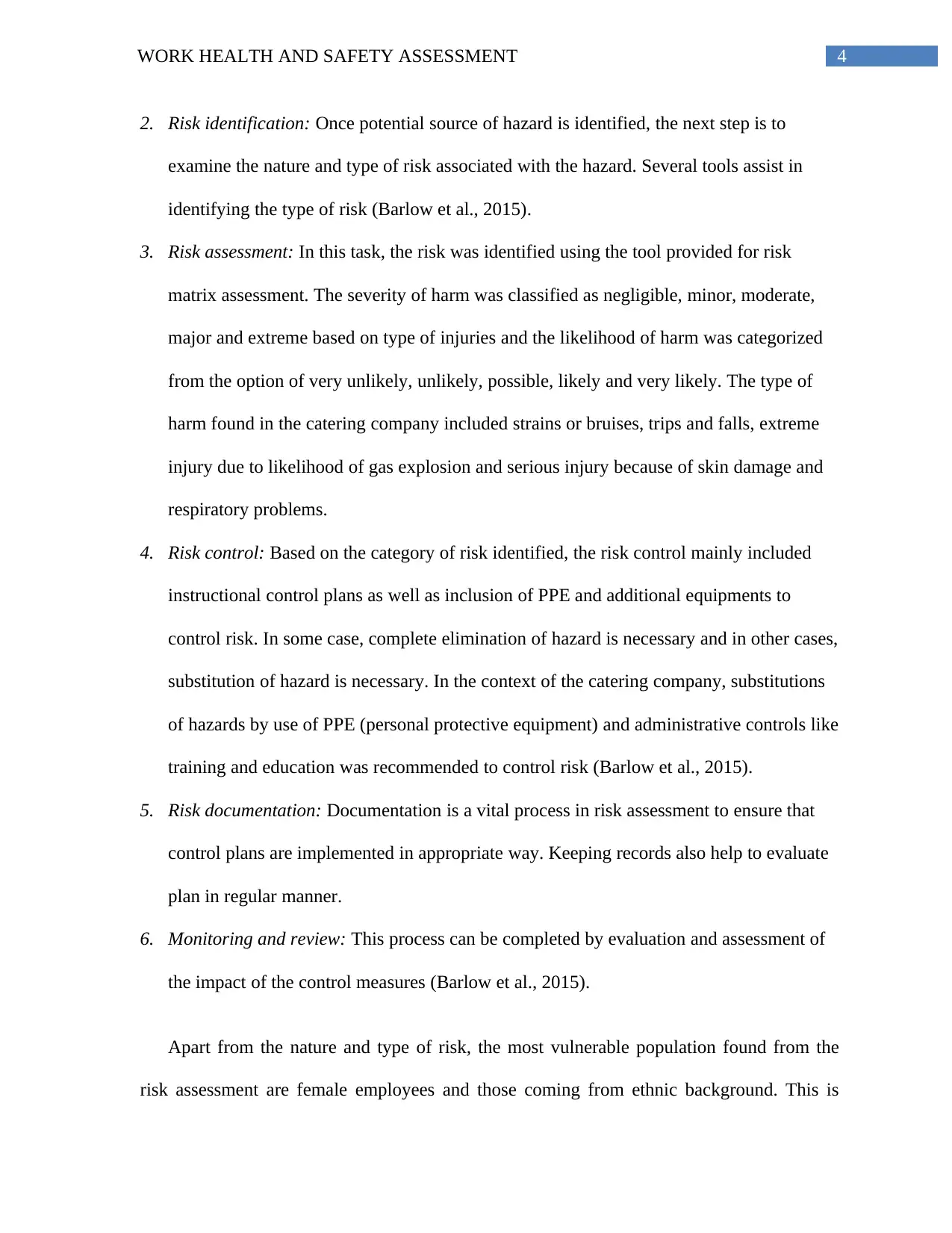
4WORK HEALTH AND SAFETY ASSESSMENT
2. Risk identification: Once potential source of hazard is identified, the next step is to
examine the nature and type of risk associated with the hazard. Several tools assist in
identifying the type of risk (Barlow et al., 2015).
3. Risk assessment: In this task, the risk was identified using the tool provided for risk
matrix assessment. The severity of harm was classified as negligible, minor, moderate,
major and extreme based on type of injuries and the likelihood of harm was categorized
from the option of very unlikely, unlikely, possible, likely and very likely. The type of
harm found in the catering company included strains or bruises, trips and falls, extreme
injury due to likelihood of gas explosion and serious injury because of skin damage and
respiratory problems.
4. Risk control: Based on the category of risk identified, the risk control mainly included
instructional control plans as well as inclusion of PPE and additional equipments to
control risk. In some case, complete elimination of hazard is necessary and in other cases,
substitution of hazard is necessary. In the context of the catering company, substitutions
of hazards by use of PPE (personal protective equipment) and administrative controls like
training and education was recommended to control risk (Barlow et al., 2015).
5. Risk documentation: Documentation is a vital process in risk assessment to ensure that
control plans are implemented in appropriate way. Keeping records also help to evaluate
plan in regular manner.
6. Monitoring and review: This process can be completed by evaluation and assessment of
the impact of the control measures (Barlow et al., 2015).
Apart from the nature and type of risk, the most vulnerable population found from the
risk assessment are female employees and those coming from ethnic background. This is
2. Risk identification: Once potential source of hazard is identified, the next step is to
examine the nature and type of risk associated with the hazard. Several tools assist in
identifying the type of risk (Barlow et al., 2015).
3. Risk assessment: In this task, the risk was identified using the tool provided for risk
matrix assessment. The severity of harm was classified as negligible, minor, moderate,
major and extreme based on type of injuries and the likelihood of harm was categorized
from the option of very unlikely, unlikely, possible, likely and very likely. The type of
harm found in the catering company included strains or bruises, trips and falls, extreme
injury due to likelihood of gas explosion and serious injury because of skin damage and
respiratory problems.
4. Risk control: Based on the category of risk identified, the risk control mainly included
instructional control plans as well as inclusion of PPE and additional equipments to
control risk. In some case, complete elimination of hazard is necessary and in other cases,
substitution of hazard is necessary. In the context of the catering company, substitutions
of hazards by use of PPE (personal protective equipment) and administrative controls like
training and education was recommended to control risk (Barlow et al., 2015).
5. Risk documentation: Documentation is a vital process in risk assessment to ensure that
control plans are implemented in appropriate way. Keeping records also help to evaluate
plan in regular manner.
6. Monitoring and review: This process can be completed by evaluation and assessment of
the impact of the control measures (Barlow et al., 2015).
Apart from the nature and type of risk, the most vulnerable population found from the
risk assessment are female employees and those coming from ethnic background. This is
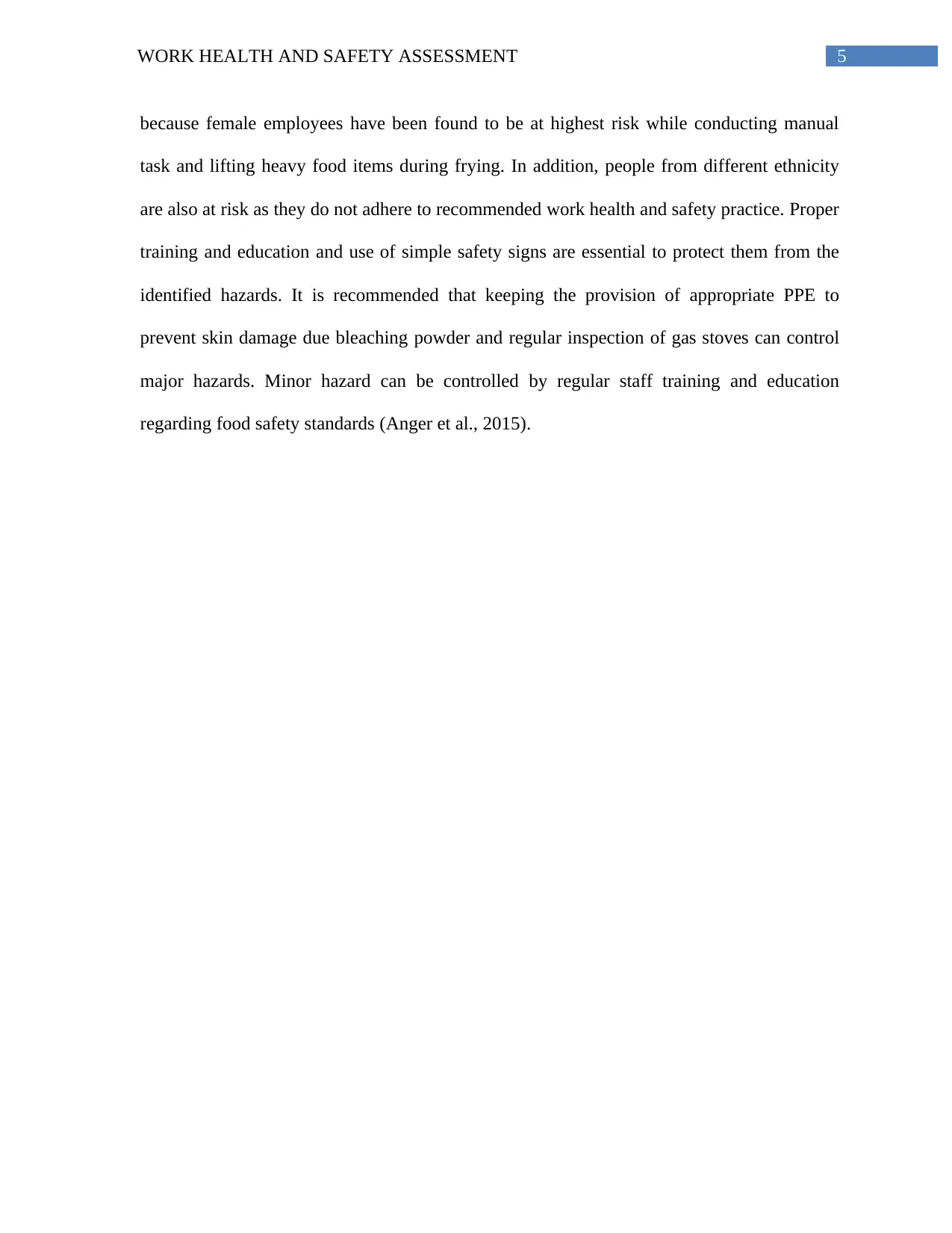
5WORK HEALTH AND SAFETY ASSESSMENT
because female employees have been found to be at highest risk while conducting manual
task and lifting heavy food items during frying. In addition, people from different ethnicity
are also at risk as they do not adhere to recommended work health and safety practice. Proper
training and education and use of simple safety signs are essential to protect them from the
identified hazards. It is recommended that keeping the provision of appropriate PPE to
prevent skin damage due bleaching powder and regular inspection of gas stoves can control
major hazards. Minor hazard can be controlled by regular staff training and education
regarding food safety standards (Anger et al., 2015).
because female employees have been found to be at highest risk while conducting manual
task and lifting heavy food items during frying. In addition, people from different ethnicity
are also at risk as they do not adhere to recommended work health and safety practice. Proper
training and education and use of simple safety signs are essential to protect them from the
identified hazards. It is recommended that keeping the provision of appropriate PPE to
prevent skin damage due bleaching powder and regular inspection of gas stoves can control
major hazards. Minor hazard can be controlled by regular staff training and education
regarding food safety standards (Anger et al., 2015).
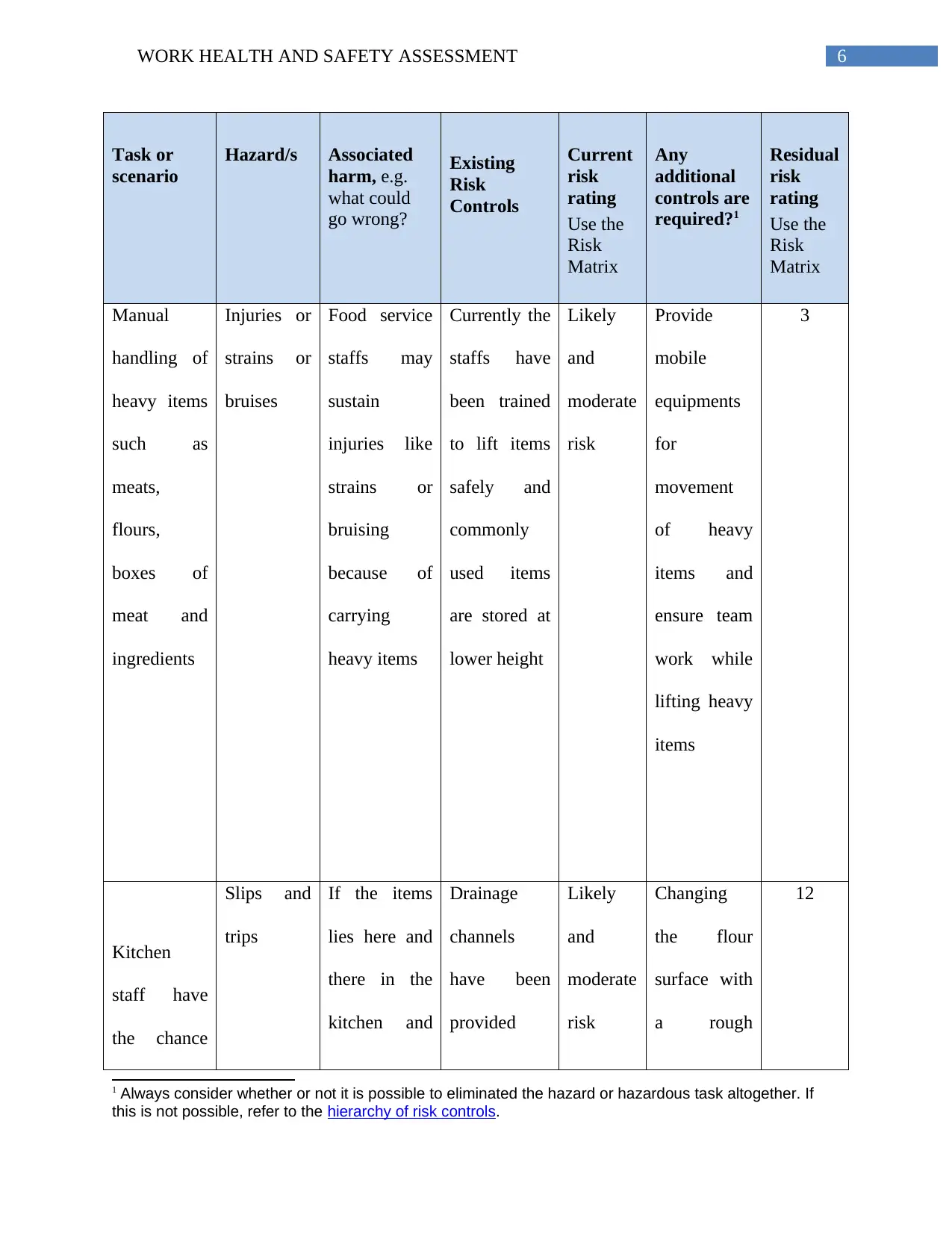
6WORK HEALTH AND SAFETY ASSESSMENT
Task or
scenario
Hazard/s Associated
harm, e.g.
what could
go wrong?
Existing
Risk
Controls
Current
risk
rating
Use the
Risk
Matrix
Any
additional
controls are
required?1
Residual
risk
rating
Use the
Risk
Matrix
Manual
handling of
heavy items
such as
meats,
flours,
boxes of
meat and
ingredients
Injuries or
strains or
bruises
Food service
staffs may
sustain
injuries like
strains or
bruising
because of
carrying
heavy items
Currently the
staffs have
been trained
to lift items
safely and
commonly
used items
are stored at
lower height
Likely
and
moderate
risk
Provide
mobile
equipments
for
movement
of heavy
items and
ensure team
work while
lifting heavy
items
3
Kitchen
staff have
the chance
Slips and
trips
If the items
lies here and
there in the
kitchen and
Drainage
channels
have been
provided
Likely
and
moderate
risk
Changing
the flour
surface with
a rough
12
1 Always consider whether or not it is possible to eliminated the hazard or hazardous task altogether. If
this is not possible, refer to the hierarchy of risk controls.
Task or
scenario
Hazard/s Associated
harm, e.g.
what could
go wrong?
Existing
Risk
Controls
Current
risk
rating
Use the
Risk
Matrix
Any
additional
controls are
required?1
Residual
risk
rating
Use the
Risk
Matrix
Manual
handling of
heavy items
such as
meats,
flours,
boxes of
meat and
ingredients
Injuries or
strains or
bruises
Food service
staffs may
sustain
injuries like
strains or
bruising
because of
carrying
heavy items
Currently the
staffs have
been trained
to lift items
safely and
commonly
used items
are stored at
lower height
Likely
and
moderate
risk
Provide
mobile
equipments
for
movement
of heavy
items and
ensure team
work while
lifting heavy
items
3
Kitchen
staff have
the chance
Slips and
trips
If the items
lies here and
there in the
kitchen and
Drainage
channels
have been
provided
Likely
and
moderate
risk
Changing
the flour
surface with
a rough
12
1 Always consider whether or not it is possible to eliminated the hazard or hazardous task altogether. If
this is not possible, refer to the hierarchy of risk controls.
Paraphrase This Document
Need a fresh take? Get an instant paraphrase of this document with our AI Paraphraser
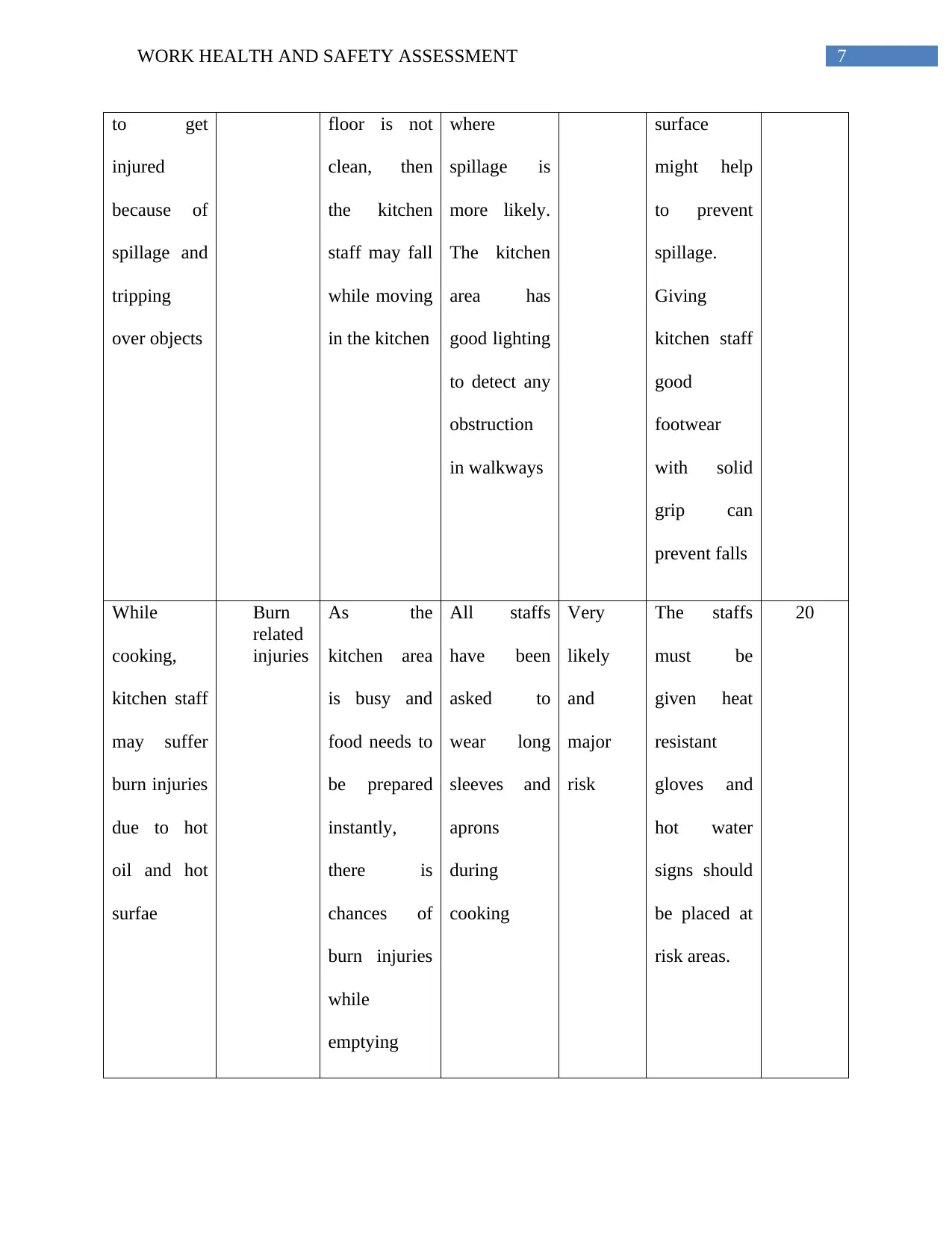
7WORK HEALTH AND SAFETY ASSESSMENT
to get
injured
because of
spillage and
tripping
over objects
floor is not
clean, then
the kitchen
staff may fall
while moving
in the kitchen
where
spillage is
more likely.
The kitchen
area has
good lighting
to detect any
obstruction
in walkways
surface
might help
to prevent
spillage.
Giving
kitchen staff
good
footwear
with solid
grip can
prevent falls
While
cooking,
kitchen staff
may suffer
burn injuries
due to hot
oil and hot
surfae
Burn
related
injuries
As the
kitchen area
is busy and
food needs to
be prepared
instantly,
there is
chances of
burn injuries
while
emptying
All staffs
have been
asked to
wear long
sleeves and
aprons
during
cooking
Very
likely
and
major
risk
The staffs
must be
given heat
resistant
gloves and
hot water
signs should
be placed at
risk areas.
20
to get
injured
because of
spillage and
tripping
over objects
floor is not
clean, then
the kitchen
staff may fall
while moving
in the kitchen
where
spillage is
more likely.
The kitchen
area has
good lighting
to detect any
obstruction
in walkways
surface
might help
to prevent
spillage.
Giving
kitchen staff
good
footwear
with solid
grip can
prevent falls
While
cooking,
kitchen staff
may suffer
burn injuries
due to hot
oil and hot
surfae
Burn
related
injuries
As the
kitchen area
is busy and
food needs to
be prepared
instantly,
there is
chances of
burn injuries
while
emptying
All staffs
have been
asked to
wear long
sleeves and
aprons
during
cooking
Very
likely
and
major
risk
The staffs
must be
given heat
resistant
gloves and
hot water
signs should
be placed at
risk areas.
20
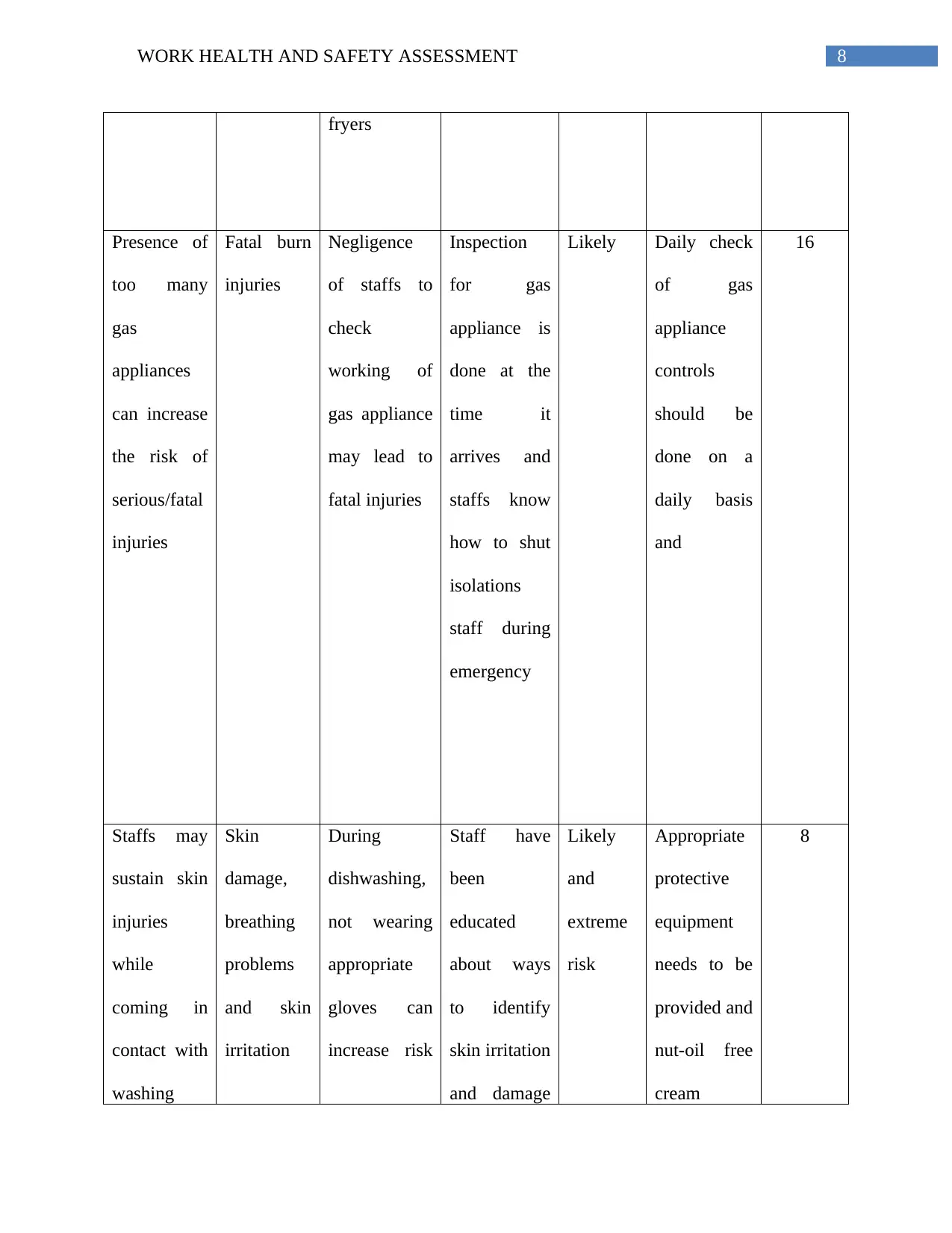
8WORK HEALTH AND SAFETY ASSESSMENT
fryers
Presence of
too many
gas
appliances
can increase
the risk of
serious/fatal
injuries
Fatal burn
injuries
Negligence
of staffs to
check
working of
gas appliance
may lead to
fatal injuries
Inspection
for gas
appliance is
done at the
time it
arrives and
staffs know
how to shut
isolations
staff during
emergency
Likely Daily check
of gas
appliance
controls
should be
done on a
daily basis
and
16
Staffs may
sustain skin
injuries
while
coming in
contact with
washing
Skin
damage,
breathing
problems
and skin
irritation
During
dishwashing,
not wearing
appropriate
gloves can
increase risk
Staff have
been
educated
about ways
to identify
skin irritation
and damage
Likely
and
extreme
risk
Appropriate
protective
equipment
needs to be
provided and
nut-oil free
cream
8
fryers
Presence of
too many
gas
appliances
can increase
the risk of
serious/fatal
injuries
Fatal burn
injuries
Negligence
of staffs to
check
working of
gas appliance
may lead to
fatal injuries
Inspection
for gas
appliance is
done at the
time it
arrives and
staffs know
how to shut
isolations
staff during
emergency
Likely Daily check
of gas
appliance
controls
should be
done on a
daily basis
and
16
Staffs may
sustain skin
injuries
while
coming in
contact with
washing
Skin
damage,
breathing
problems
and skin
irritation
During
dishwashing,
not wearing
appropriate
gloves can
increase risk
Staff have
been
educated
about ways
to identify
skin irritation
and damage
Likely
and
extreme
risk
Appropriate
protective
equipment
needs to be
provided and
nut-oil free
cream
8
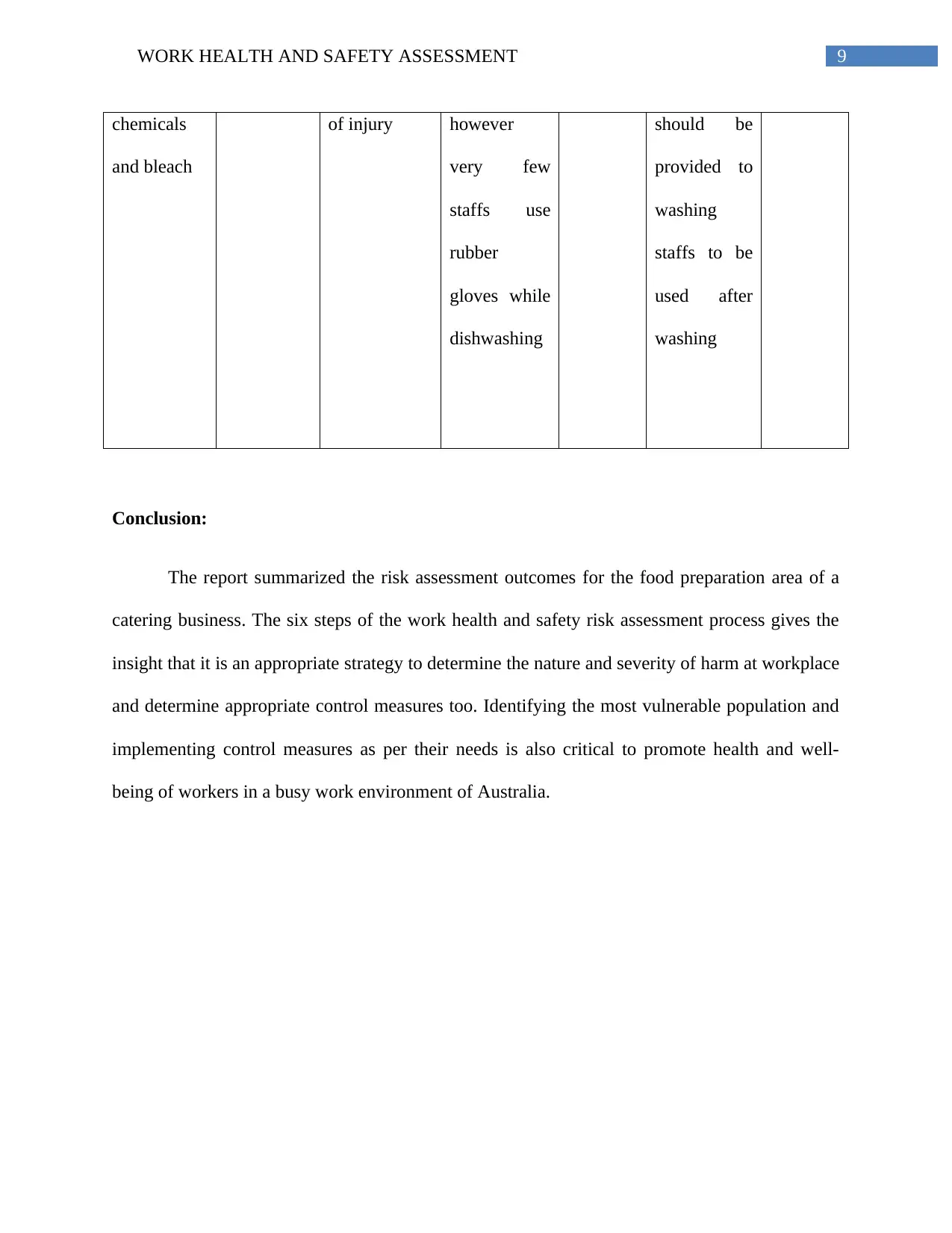
9WORK HEALTH AND SAFETY ASSESSMENT
chemicals
and bleach
of injury however
very few
staffs use
rubber
gloves while
dishwashing
should be
provided to
washing
staffs to be
used after
washing
Conclusion:
The report summarized the risk assessment outcomes for the food preparation area of a
catering business. The six steps of the work health and safety risk assessment process gives the
insight that it is an appropriate strategy to determine the nature and severity of harm at workplace
and determine appropriate control measures too. Identifying the most vulnerable population and
implementing control measures as per their needs is also critical to promote health and well-
being of workers in a busy work environment of Australia.
chemicals
and bleach
of injury however
very few
staffs use
rubber
gloves while
dishwashing
should be
provided to
washing
staffs to be
used after
washing
Conclusion:
The report summarized the risk assessment outcomes for the food preparation area of a
catering business. The six steps of the work health and safety risk assessment process gives the
insight that it is an appropriate strategy to determine the nature and severity of harm at workplace
and determine appropriate control measures too. Identifying the most vulnerable population and
implementing control measures as per their needs is also critical to promote health and well-
being of workers in a busy work environment of Australia.
Secure Best Marks with AI Grader
Need help grading? Try our AI Grader for instant feedback on your assignments.
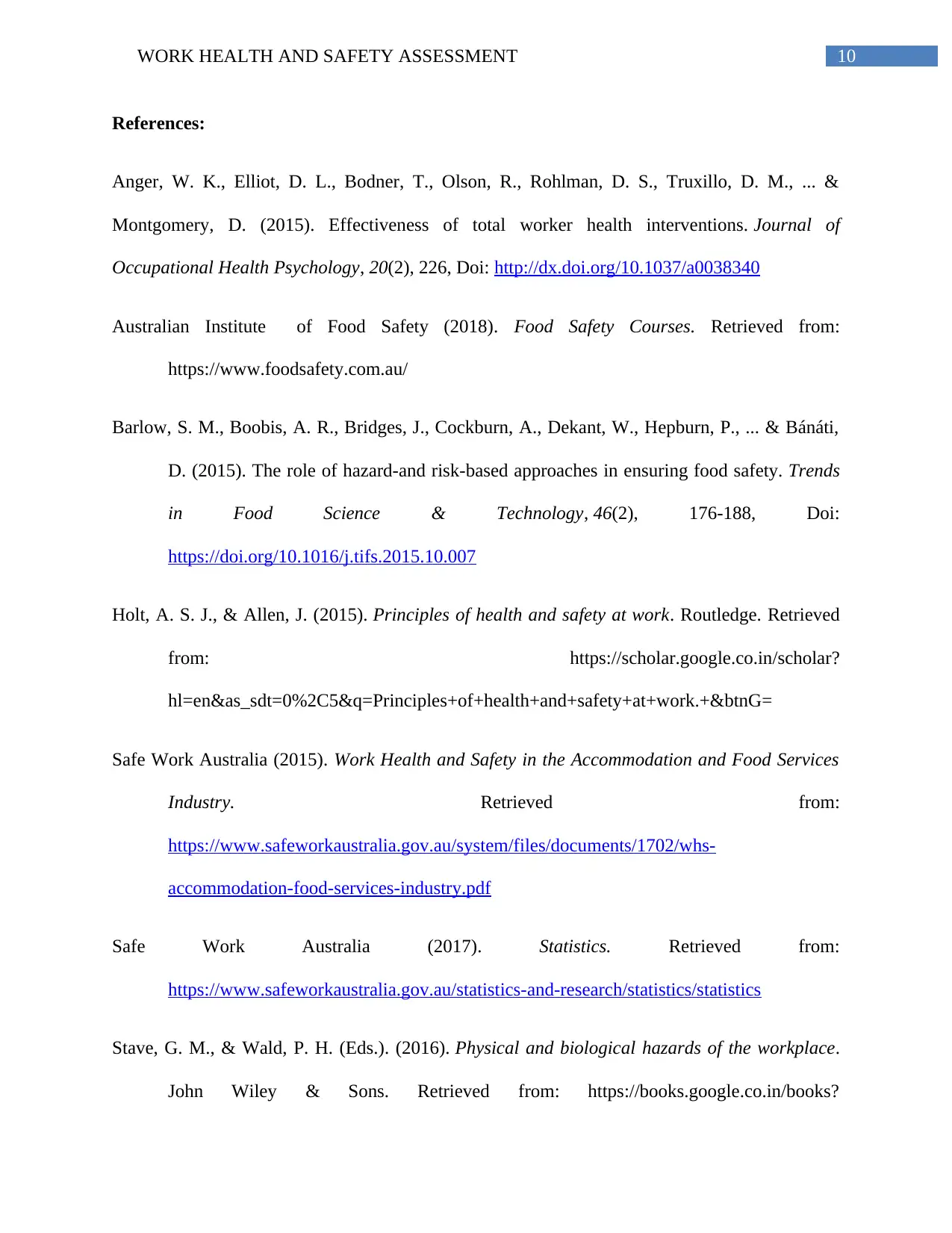
10WORK HEALTH AND SAFETY ASSESSMENT
References:
Anger, W. K., Elliot, D. L., Bodner, T., Olson, R., Rohlman, D. S., Truxillo, D. M., ... &
Montgomery, D. (2015). Effectiveness of total worker health interventions. Journal of
Occupational Health Psychology, 20(2), 226, Doi: http://dx.doi.org/10.1037/a0038340
Australian Institute of Food Safety (2018). Food Safety Courses. Retrieved from:
https://www.foodsafety.com.au/
Barlow, S. M., Boobis, A. R., Bridges, J., Cockburn, A., Dekant, W., Hepburn, P., ... & Bánáti,
D. (2015). The role of hazard-and risk-based approaches in ensuring food safety. Trends
in Food Science & Technology, 46(2), 176-188, Doi:
https://doi.org/10.1016/j.tifs.2015.10.007
Holt, A. S. J., & Allen, J. (2015). Principles of health and safety at work. Routledge. Retrieved
from: https://scholar.google.co.in/scholar?
hl=en&as_sdt=0%2C5&q=Principles+of+health+and+safety+at+work.+&btnG=
Safe Work Australia (2015). Work Health and Safety in the Accommodation and Food Services
Industry. Retrieved from:
https://www.safeworkaustralia.gov.au/system/files/documents/1702/whs-
accommodation-food-services-industry.pdf
Safe Work Australia (2017). Statistics. Retrieved from:
https://www.safeworkaustralia.gov.au/statistics-and-research/statistics/statistics
Stave, G. M., & Wald, P. H. (Eds.). (2016). Physical and biological hazards of the workplace.
John Wiley & Sons. Retrieved from: https://books.google.co.in/books?
References:
Anger, W. K., Elliot, D. L., Bodner, T., Olson, R., Rohlman, D. S., Truxillo, D. M., ... &
Montgomery, D. (2015). Effectiveness of total worker health interventions. Journal of
Occupational Health Psychology, 20(2), 226, Doi: http://dx.doi.org/10.1037/a0038340
Australian Institute of Food Safety (2018). Food Safety Courses. Retrieved from:
https://www.foodsafety.com.au/
Barlow, S. M., Boobis, A. R., Bridges, J., Cockburn, A., Dekant, W., Hepburn, P., ... & Bánáti,
D. (2015). The role of hazard-and risk-based approaches in ensuring food safety. Trends
in Food Science & Technology, 46(2), 176-188, Doi:
https://doi.org/10.1016/j.tifs.2015.10.007
Holt, A. S. J., & Allen, J. (2015). Principles of health and safety at work. Routledge. Retrieved
from: https://scholar.google.co.in/scholar?
hl=en&as_sdt=0%2C5&q=Principles+of+health+and+safety+at+work.+&btnG=
Safe Work Australia (2015). Work Health and Safety in the Accommodation and Food Services
Industry. Retrieved from:
https://www.safeworkaustralia.gov.au/system/files/documents/1702/whs-
accommodation-food-services-industry.pdf
Safe Work Australia (2017). Statistics. Retrieved from:
https://www.safeworkaustralia.gov.au/statistics-and-research/statistics/statistics
Stave, G. M., & Wald, P. H. (Eds.). (2016). Physical and biological hazards of the workplace.
John Wiley & Sons. Retrieved from: https://books.google.co.in/books?
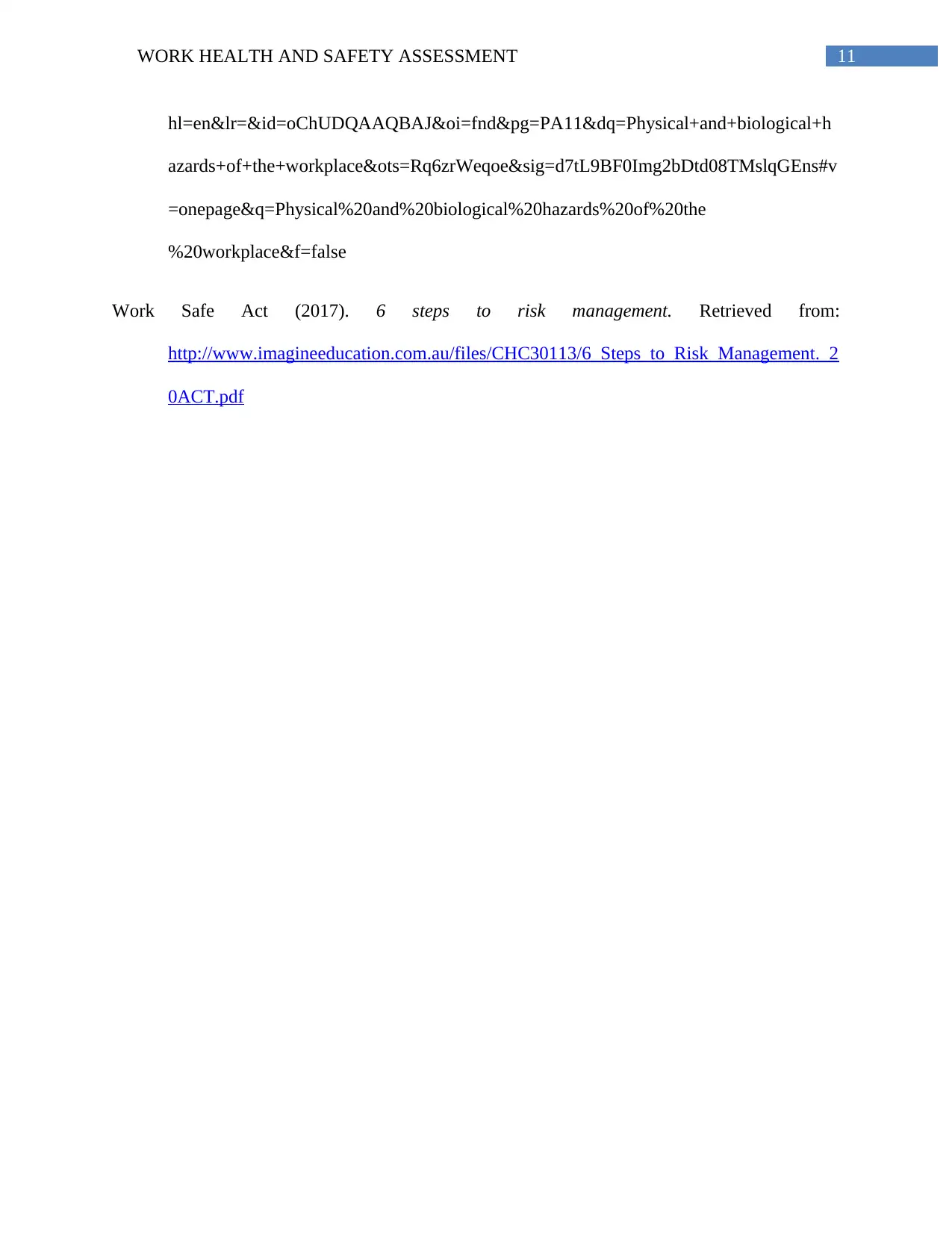
11WORK HEALTH AND SAFETY ASSESSMENT
hl=en&lr=&id=oChUDQAAQBAJ&oi=fnd&pg=PA11&dq=Physical+and+biological+h
azards+of+the+workplace&ots=Rq6zrWeqoe&sig=d7tL9BF0Img2bDtd08TMslqGEns#v
=onepage&q=Physical%20and%20biological%20hazards%20of%20the
%20workplace&f=false
Work Safe Act (2017). 6 steps to risk management. Retrieved from:
http://www.imagineeducation.com.au/files/CHC30113/6_Steps_to_Risk_Management._2
0ACT.pdf
hl=en&lr=&id=oChUDQAAQBAJ&oi=fnd&pg=PA11&dq=Physical+and+biological+h
azards+of+the+workplace&ots=Rq6zrWeqoe&sig=d7tL9BF0Img2bDtd08TMslqGEns#v
=onepage&q=Physical%20and%20biological%20hazards%20of%20the
%20workplace&f=false
Work Safe Act (2017). 6 steps to risk management. Retrieved from:
http://www.imagineeducation.com.au/files/CHC30113/6_Steps_to_Risk_Management._2
0ACT.pdf
1 out of 12
Your All-in-One AI-Powered Toolkit for Academic Success.
+13062052269
info@desklib.com
Available 24*7 on WhatsApp / Email
![[object Object]](/_next/static/media/star-bottom.7253800d.svg)
Unlock your academic potential
© 2024 | Zucol Services PVT LTD | All rights reserved.





